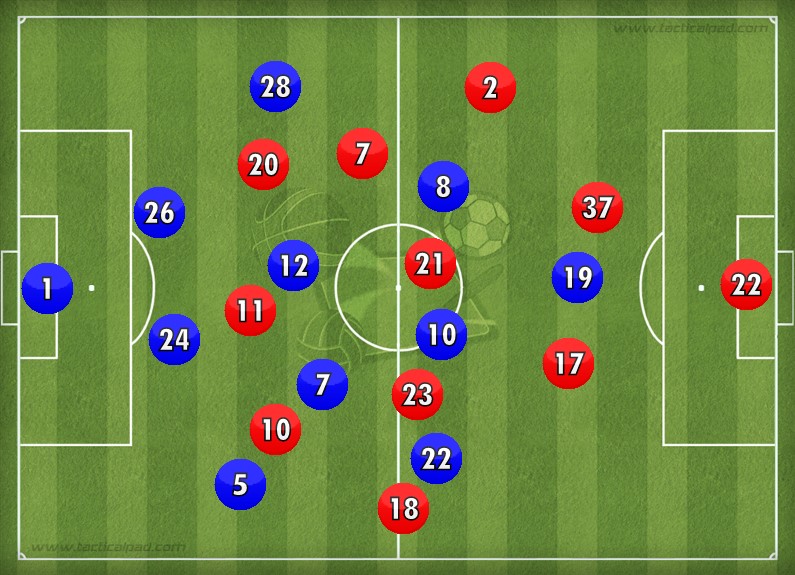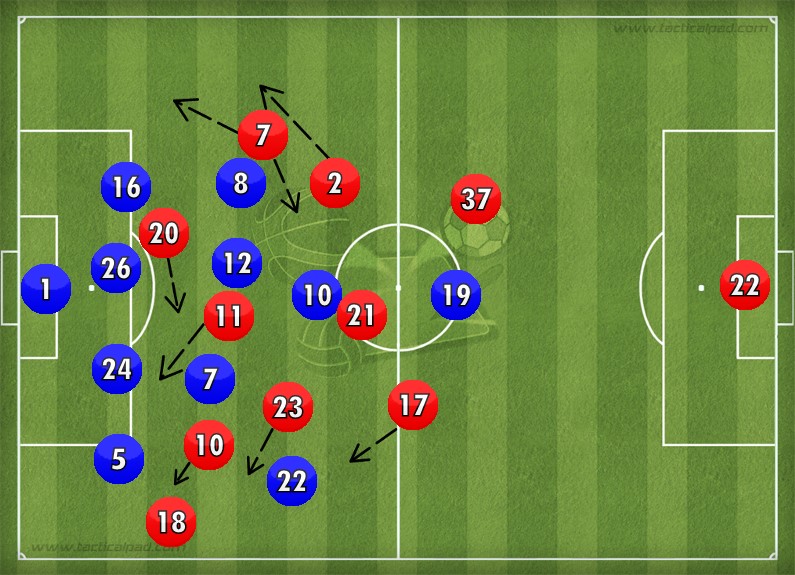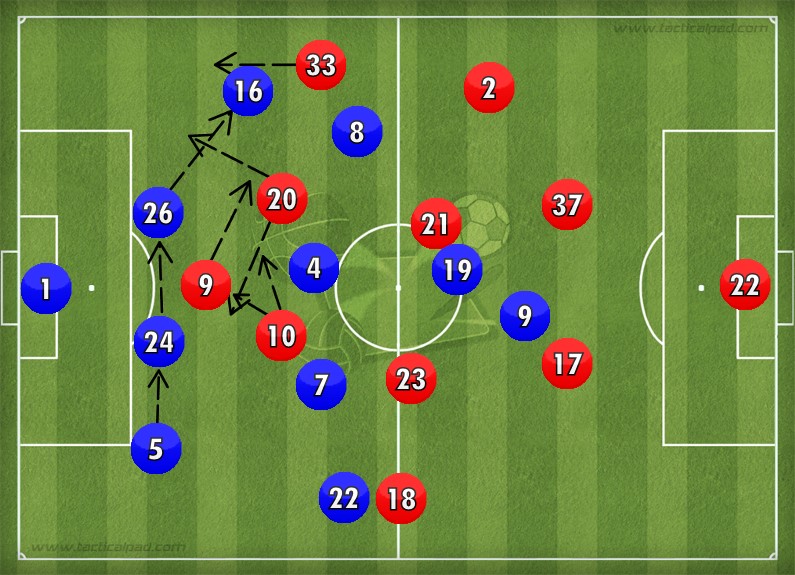Chelsea’s horrendous start to the season has been matched to a lesser degree by Liverpool’s underwhelming performances. But when the due clashed at the Bridge on Saturday, it clearly felt like a team on the wane was taking on one on the up. Klopp’s energy was rubbing off on the Kop, and Mourinho’s brooding intensity seemed to be grinding Chelsea down. Daniel Wong analyses the result.
Jose Mourinho’s future at Stamford Bridge took another hit as Liverpool sunk Chelsea 3-1 at Stamford Bridge in what was Jurgen Klopp’s first ever Premier League victory. Chelsea have suffered their worst start to a league season since 1978, and it is obvious that there is something very wrong at the club. Organization had been a word almost synonymous with Jose Mourinho’s Chelsea side. However, this organization has vanished this season, and focusing on the lack of shape and organization in each of the goals explains how Chelsea imploded to a famous defeat at the Bridge.
Line Ups:

Chelsea 1-3 Liverpool
Chelsea: Begovic; Azpilicueta, Terry, Cahill, Zouma; Mikel, Ramires; Oscar, Hazard, Willian; Costa (4-2-3-1)
Liverpool: Mignolet; Moreno, Sakho, Skrtel, Clyne; Can, Lucas, Milner; Coutino, Lallana; Firmino (4-3-2-1)
For the first time since Fabregas’ arrival, he found himself on the bench with Matic. Ramires and Mikel found themselves as the defensive midfielders on the day, with Ramires given the license to fill a sort of box-to-box role. With Willian on Chelsea’s right, and Hazard central, Chelsea looked to counter on Liverpool’s left, while also having the option to go direct to Diego Costa to link up attacks when in possession. Though starting on Chelsea’s left, Oscar tended to drift closer into the central areas of the field. The team Jose Mourinho chose was clearly intended to be a balance between attack and defence, but as was the ongoing trend this season for the Blues, a shocking lack of organization proved to be their downfall.
Klopp on the other hand opted to start the same team he started off against Southampton, with the exception of Firmino, who took the struggling Origi’s place in the starting eleven. Meanwhile, Benteke was left on the bench, and with a lack of aerial presence, it was obvious that Liverpool would be forced to play to feet. Firmino looked to drop deep to receive the ball to feet, while Lallana and Coutinho once again filled the attacking midfielder roles, looking to attack space and pull defenders with them. Clyne and Moreno were once again given the license to attack the wings.
Chelsea in Defence
While Chelsea were set up as a 4-2-3-1, they switched to a flat zonal 4-4-1-1 in defence, looking to either hit Liverpool on the counter, or to win back possession and go direct to Costa and the flanks. Ideally, two banks of four would exist, with the midfield four consisting of Willian, Ramires, Mikel, and Oscar, while Hazard would try his best to stay higher up like Mane did last week for Southampton. If Chelsea won the ball and countered, they could do so with pace via Willian, Hazard, and Costa. Chelsea’s back line would drop deep, but would come out to challenge any passes that entered their zone.
This tactic would have worked in theory, but it required a tremendous amount of discipline. However, through the entirety of the match, Chelsea’s lack of discipline and organization was noticeable, and was found out time and time again. It is not a criticism of the system, but rather of the players picked for the system. Willian, Oscar, and Hazard are not the type of players people generally associate with discipline. Willian and Hazard dropped but didn’t seem as interested to actively defend, instead looking to position themselves better for counter attacks. Despite this, Mourinho persisted in having his team defend in tight banks of four, but throughout the match, the desired banks of four were a rarity. Furthermore, with Chelsea’s back four dropping deeper and deeper, huge gaps of space appeared throughout the match for Coutinho, Lallana, and Firmino to all go into and receive the ball, and this disjointedness resulted in Liverpool’s first goal.
Liverpool adapting to Firmino in possession
Without Benteke or Origi, Liverpool were forced to accommodate Roberto Firmino, but they adapted brilliantly. As they had done all season, Liverpool played out of their own half through the flanks, with Can and Lucas dropping deep to act as pivots. Without their target man in the first half, Liverpool was reluctant to go long and instead resorted to all their players dropping deep to help build their way out of their own half. It was very common to see Firmino, Coutinho, and Lallana come deep to receive the ball, with instances where Firmino dropped as deep as where Milner usually was. Lallana drifted into space and would occasionally act as a false nine if Firmino did drop. Once they passed out of the press, Liverpool did not look to pass around and simply maintain possession, instead transitioning straight into an attack.

Liverpool prefer to build on the left and centre, with Firmino dropping deep, causing overloads on Mikel and Ramires. Gaps also form as Chelsea drop deep. Cahill occasionally follows Firmino but is reluctant to leave shape
To get the ball higher up into the flanks of the final third was another issue, but one that was dealt with fairly easily once Chelsea began to sit deeper and deeper. Since Firmino was dropping deep to receive the ball, and Chelsea’s back four kept retreating into their box, there were overloads on Mikel and Ramires, who found themselves having to defend against Firmino, Lallana, and Coutinho – this created space between the two lines of defence. It was almost as if Chelsea had forgotten how to deal with the lack of a striker, instead opting to stay deep and not get drawn out of position. Once Firmino received the ball, Coutinho and Lallana would attack gaps in the central area of Chelsea’s defence from deep, which pushed Mikel and Ramires deeper to cover their runs, creating massive spaces for Moreno and Clyne to be picked out by Lucas once the ball was recycled.

Liverpool in attack: Chelsea drops very deep but midfield does not providing space in between the lines to Lallana, Coutinho and Firmino. The central nature of the attack give Moreno and Clyne space to enable switches of play
Unlike previous matches, Liverpool saw the majority of their attacks begin on the left hand side, but would look to penetrate on the right. If the attack on one flank was sufficiently covered, Liverpool showed great patience in recycling the ball around the midfield. Lucas looks improved with every single game under Klopp and showed that he has added more to his game rather than just defending. Playing a Busquets styled role on the day to receive the ball from one flank in the centre, he would recycle possession and keep the attack going by passing it to the other flank to stretch the Chelsea side. As Chelsea defended in tight banks of four, if Liverpool’s possession was higher up the left flank, Clyne would push higher up and more centrally, following where Oscar went in order to close him down immediately should the ball fall to him. Once the ball was cycled back to the midfield and Lucas, Clyne and Milner would push out wide to enable the shift over to the right, while the opposite would be true if the play was held up on the right flank. This caused Chelsea’s defence and midfield to constantly shift and get stretched when Lucas switched the play, unless they remained tight and organized. But as noted, this wasn’t the case, as seen in the first goal.

Liverpool in deep attacking possession on left flank: Coutinho, Firmino, Can, and Lallana all go to support the play. Lucas hangs further back to receive the ball and when he does receive, Clyne or Milner peel off to the wings. Note Clyne’s position, intended to stay tight on Oscar and press to prevent counter-attacks and recover possession
As it happened: Goal Analysis
4’ Ramires Goal: Though Chelsea attacked with flair throughout the match, they were hounded by Liverpool off the ball, and they ended up flicking balls early instead of holding up the ball and performing one-twos to get around Liverpool’s defence. The end product of this was that the majority of Chelsea’s possession and attacks came to nothing. This early goal was one of Chelsea’s few good moves in the whole match, and they were rewarded with a goal. Costa holds the ball up well after Hazard recycled possession in the attacking third. Two intelligent runs by Azpilicueta and Ramires followed this hold-up play. Azpilicueta runs along the outside of the touchline around Costa, and because of Costa’s presence, Milner has to run around the Spanish international and has difficulty following the run. Unfortunately, Milner follows this up with a poor attempt at a challenge and gives Azpilicueta seconds to get the ball onto his favoured right foot, and pick out a cross. Ramires makes his run from deep in the midfield, and after a bit of poor awareness from Moreno, gets his head on the cross to provide a bullet header that gave Mignolet no chance.
45’+2 Coutinho Goal: Liverpool’s breakthrough came in the dying stages of the first half, and was a result of extremely poor defending from Chelsea, a trend which followed for all of Liverpool’s goals. The ball is shifted to the right flank to Milner, and right away there are a multitude of issues visible, which is a huge problem for Chelsea since they were relying on organization and sitting deep to hit Liverpool on the counter. A massive gap appears between Terry and Azpilicueta, compounded by the fact that the entire Chelsea back line and midfield does not shift over to restrict any space. The desired midfield bank of four is also not present, with Willian (who is not even in the picture) not joining the midfield to help defend. As a result, there are three Liverpool players against Cahill and Zouma, which has undoubtedly affected their decision not to shift over. Terry then makes an error in not staying tight with Firmino, who is allowed to move into the massive gap to lays the ball off for Coutinho. Coutinho is in another gap of space following the lack of a midfield shift since Mikel has dropped deeper to fill in the space Terry has left, and as a result, Ramires is forced to immediately close Coutinho down in order to prevent a shot. However, he falls victim to a brilliantly faked shot, which is followed up by an equally brilliant weaker foot finish to ensure the Reds went level into the break.
In the second half, Chelsea pressed higher up the field and looked much more dangerous. Kenedy came on for Hazard in the 58th minute and made an immediate impact, showing positivity in playing simple and going direct. With Chelsea turning up the pressure and Liverpool being forced to clear the ball long, Klopp substituted Milner for Christian Benteke and changed to a 4-2-3-1. It was a brilliant substitution, as Liverpool had struggled to pass their way out of Chelsea’s press in the second half, with Firmino, Lallana, and Coutinho all finding difficulties in receiving the ball in the second half. Benteke looked to occupy the inside of flanks and acted as a target man to bring the ball down, as well as dropping deep occasionally to link up with Lallana, Coutinho, and Firmino. This was followed by two poor substitutions by Mourinho, which really highlighted the sort of drama and desperation going on at Chelsea. Following the substitutions, Chelsea lost all sort of organization, from attack to defence, and the Blues looked like they were playing as individuals, without any instructions. This left Chelsea’s defence to their own devices, and from the weakness on their left side, to the defensive failings in the midfield, Liverpool was allowed to score twice with only a few players in the attack.

The first change was Fabregas, on for Mikel, which definitely was not a like-for-like substitution. It was an immature substitution, considering Benteke was causing Chelsea problems, while they were also finding a little more luck pushing higher up from being more solid in the midfield. However, Mourinho was determined to make a point in substituting Mikel, who was on a yellow, to jab at the fact that Lucas had avoided a second yellow just minutes earlier. Fabregas has been criticized for his inability to defend ever since he returned to England, and why Matic did not come on instead, is one only a question Mourinho can answer. To try and make up for this substitution, Azpilicueta was instructed to stay tight with Lallana, while Kenedy would drop deeper to cover for Azpilicueta. Unfortunately, this saw Kenedy found out time and time again, as Benteke set up shop on his flank. The following lack of organization and exposing of Kenedy resulted in Liverpool’s first goal.
74’ Coutinho goal: The move starts with Benteke winning the ball in the air after Sakho sent a long and direct ball into the big Belgian. Azpilicueta had stayed tight with Lallana, which put Kenedy in an aerial duel with Benteke, which he lost out to. Coutinho and Lallana make runs across each other into the central area of the field, which again brought the Chelsea back four all together. It is a little bit of luck, as Lallana misses his attempt to control the ball (which probably would’ve resulted in Chelsea winning the ball), and the ball falls to Coutinho, who also gets lucky with a deflected shot that nestled in the back of the net, putting Liverpool in the lead. However, it is worthy to point out that Kenedy doesn’t even bother to follow Benteke following his lost challenge, and the Belgian was completely unmarked and open, had Coutinho elected to pick him out instead of shooting.
Following Coutinho’s second goal, Ibe came on for Firmino, and in an act of desperation, Mourinho threw on Falcao for Azpilicueta, relegating Kenedy to the very unfamiliar left back position. The poor 19 year old was taken advantage of by Benteke and Ibe alike. Just before Benteke’s goal, Ibe had a shooting opportunity blocked by Terry, after Kenedy made a poor attempt to challenge. His defensive frailty caused Terry to make challenges he shouldn’t have been making in his attempts to help out the young Brazilian. This was key in Liverpool’s third goal, courtesy of Benteke.
83’ Benteke goal: The attack begins once again with another aerial duel won by the big Belgian, heading it on for Jordon Ibe. Having set up shop on the Chelsea’s left, Terry charged out of his position in an attempt to help Kenedy win the duel, but instead loses out and is caught out of position. Ibe is given time and space to control the ball while Lallana, Benteke, and Coutinho all attack space in the box. To make things worse, Chelsea didn’t seem in much of a hurry to get back to plug the gaps that had appeared, with Fabregas, Kenedy, and Terry all jogging back to defend, contrary to Lallana and Benteke, who had sprinted to attack space. Ibe played a neat little pass to Lallana that the jogging Terry was unable to get to. Lallana then showed great awareness to dummy the ball for Benteke, and after a faked shot and a lucky deflection, the Belgian scored Liverpool’s third to seal the win.
Conclusion
It was shocking to see Chelsea look as lost as they did on Saturday. Their lack of organization and game plan, especially after their substitutions, really explained their loss. While Liverpool played well and got the three goals to their name, Chelsea really only had themselves to blame for the goals. From the lack of duties performed that were expected of the players who started, to the poor substitutions and subsequent lack of organization, Mourinho and Chelsea truly imploded, having started so well in the opening stages of the match. Liverpool did well to get back into the game, and the brilliant all-round performance of Lucas Leiva helped ensure that almost every single one of Chelsea’s disjointed attacks were broken up. Furthermore, the introduction of Benteke turned for Milner turned out to be a masterstroke, with the Belgian winning almost all of his duels and playing a massive part in both of Liverpool’s second half goals. It hasn’t helped Mourinho that the entire team has lost form, from last season’s player of the year in Hazard (who was essentially invisible throughout the match), to the ageing and struggling defence. The poor performances and lack of effort highlights the apparent loss of belief and this latest setback leaves the under-pressure Chelsea boss to ponder what he can do next to stop the rut.
Written by Daniel Wong
- Tactical Analysis: Liverpool 4-0 Arsenal | Klopp Exposes Wenger’s Stubbornness - September 2, 2017
- Analysis: How Manchester City found the right balance between Attack and Defence against Manchester United - September 16, 2016
- Euro 2016 Tactical Analysis: France 0-1 Portugal (AET) | Substitutions the key for Portugal - July 14, 2016




































































